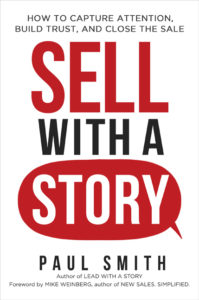Podcast: Play in new window | Download | Embed
Subscribe: RSS
Podcast (sell-with-a-story-series1): Play in new window | Download | Embed
Subscribe: RSS
 {The 18th in a series of the 25 most useful sales stories}
{The 18th in a series of the 25 most useful sales stories}
One of the final, and most common objections buyers have to what you’re selling is price.
So, if you’re at the point that you’re negotiating price, congratulations. You’ve got a prospect interested in what you’re selling, and you’ve probably resolved every other objection they have.
Of course, most salespeople have an explicit method for negotiating price. And if you’ve got one, and it works, great. Keep using it. Storytelling isn’t meant to replace that. But it can augment it.
Here’s an example that I think is instructive on many levels.
If you have to pay for anything up front in this industry, it’s a rip-off!”
Now, that’s a familiar but unfortunate saying in the modeling and talent business. It’s familiar because it’s been floating around for decades. It’s unfortunate because it’s not true—at least it’s not if you want the best odds of success.
You know, a lot of aspiring models naively think they can land a lucrative contract with no training, no experience, and no understanding of the business — all just based on their good looks. “All I need,” she might think, “is an agent to represent me.”
And, not surprisingly, that rarely works. Just like in any industry, people with relevant skills and experience are in a better position to succeed than those without. And one of the best places for that aspiring model to get that skill and experience is Excel Models & Talent.
For 25 years, the owner, Melissa Moody, has been placing models in women’s magazines like Vogue, Elle, and Cosmopolitan, and on runways at fashion shows all over the world. Some of the singers and dancers she represents have won prestigious awards, including a Grammy, an American Music Award, and a Teen Choice Award.
But, unlike a traditional talent agency, Excel doesn’t just match clients with models and collect a commission for brokering the deal. They also train their students in modeling, acting, professional etiquette, and even the business side of the industry. And Melissa personally takes them to competitions in New York, Los Angeles, and Paris every year to get experience.
So it’s understandable that Melissa needs to charge her students something up front for those services. But still, she often gets the objection that “you shouldn’t have to pay for anything up front in this industry” from a potential client, which is typically a 14-year-old girl accompanied by her parents.
In those situations, Melissa has three responses she often uses. First, she asks them to look around the office. “What do you see? How do you think I pay for the classrooms, the furniture, the lights?” Melissa’s not just sitting in her basement with a computer and a phone brokering deals. She’s running a real business.
Sometimes that works. Sometimes it doesn’t.
If not, she asks the prospective model, or her parents, what they do for a living. “Oh, good, you’re an accountant,” she might say. “Because I really need my taxes done. But I don’t want to pay for it unless I get a refund. Will you do them for me?” Of course not. Sometimes that works. Sometimes it doesn’t.
If those two responses don’t resolve the objection, Melissa pulls out her biggest gun: a story. And her story is about a young lady we’ll call Kristine. Kristine had the makings of a world-class model and was one of Melissa’s best students. During one of the annual New York competitions, Kristine came in first runner-up out of 1,200 young ladies. Back home the next week, she got an unprecedented 42 callbacks from agents and clients. Melissa helped her pick the best opportunities, and Kristine and her parents were off to New York again to sign a deal.
The day of the big meeting, Melissa got a call from Kristine, from her cell phone, sitting in the backseat of a cab heading to the client’s office to sign the contract. Kristine was in tears.
“What’s wrong?” Melissa asked.
Kristine was having second thoughts. It turns out, being a model was never really her idea. It was her mom’s. Kristine wanted to be successful—just not in this business. “Melissa, I graduated at the top of my class. I don’t want to make my living off my looks. I want to go to business school and run a company, like you! What should I do?”
Now, at this point, Melissa stops telling the story and explains to her prospect how she would have answered the question if Kristine hadn’t paid up front for the training and experience she’d gotten from Excel. She says, “I would have told her, ‘Kristine, I’ve got $15,000 invested in you and a contract. Now you get your butt in that office and sign those papers so I can get paid!’ But because I don’t work that way, what I actually told her was this: ‘Kristine, follow your heart. Come home and pursue your dream.’ ” And that’s exactly what Kristine did.
The Lessons
I think there are a couple of lessons in all this.
First, Melissa knows her biggest and best weapon in negotiating price is a story, not a fact or an argument.
Second, this particular story allows her to highlight the benefit of her pricing policy for the customer, not for her. That’s very different from her first two attempts. The need to pay for lights and furniture is a reason Melissa needs to charge a fee. The analogy of the free tax service also explains why Melissa needs to charge up front. But the story about Kristine shows a benefit to the student. Paying up front gets you an agent who’s financial best interests are aligned with yours. And that can keep you out of a commitment you might not want to have later on.
As far as Melissa’s concerned, anything less would be a rip-off.
Recommendation
So, if you find yourself defending your pricing, think of a similar story about how the price you charge is good for the customer, not you. What would happen badly for customers if they paid less and your product was commensurately cheaper in quality?
Use these links to subscribe to this podcast on iTunes or Stitcher, or Podbean.
Source: Sell with a Story: How to Capture Attention, Build Trust, and Close the Sale, by Paul Smith.
—
 Paul Smith is one of the world’s leading experts on business storytelling. He’s a keynote speaker, storytelling coach, and bestselling author of the books Lead with a Story, Parenting with a Story, and Sell with a Story.
Paul Smith is one of the world’s leading experts on business storytelling. He’s a keynote speaker, storytelling coach, and bestselling author of the books Lead with a Story, Parenting with a Story, and Sell with a Story.


 Connect with him via email here.
Connect with him via email here.
Follow him on Facebook, LinkedIn, Twitter, and Instagram.
Sign up for his newsletter here to get one new story a week delivered to your inbox.

